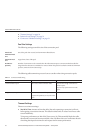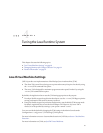
When the new generation lls up, it triggers a minor collection in which the surviving objects
are moved to the old generation. When the old generation lls up, it triggers a major collection
which involves the entire object heap.
Both HotSpot and Solaris JDK use thread local object allocation pools for lock-free, fast, and
scalable object allocation. So, custom object pooling is not often required. Consider pooling
only if object construction cost is high and signicantly aects execution proles.
Choosing the Garbage Collection Algorithm
Pauses during a full GC of more than four seconds can cause intermittent failures in persisting
session data into HADB.
While GC is going on, the Application Server isn’t running. If the pause is long enough, the
HADB times out the existing connections. Then, when the application server resumes its
activities, the HADB generates errors when the application server attempts to use those
connections to persist session data. It generates errors like, “Failed to store session data,”
“Transaction Aborted,” or “Failed to connect to HADB server.”
To prevent that problem, use the CMS collector as the GC algorithm. This collector can cause a
drop in throughput for heavily utilized systems, because it is running more or less constantly.
But it prevents the long pauses that can occur when the garbage collector runs infrequently.
▼
To use the CMS collector
Make sure that thesystem is notusing 100 percent ofits CPU.
CongureHADB timeouts, as describedin the Administration Guide.
Congurethe CMS collector in theserver instance.
To do this, add the following JVM options:
■
-XX:+UseConcMarkSweepGC
■
-XX:SoftRefLRUPolicyMSPerMB=1
Additional Information
Use the jvmstat utility to monitor HotSpot garbage collection. (See “Further Information” on
page 91
For detailed information on tuning the garbage collector, see Tuning Garbage Collection with
the 5.0 Java Virtual Machine
.
1
2
3
ManagingMemoryandGarbage Collection
Chapter4 • TuningtheJavaRuntimeSystem 85


















